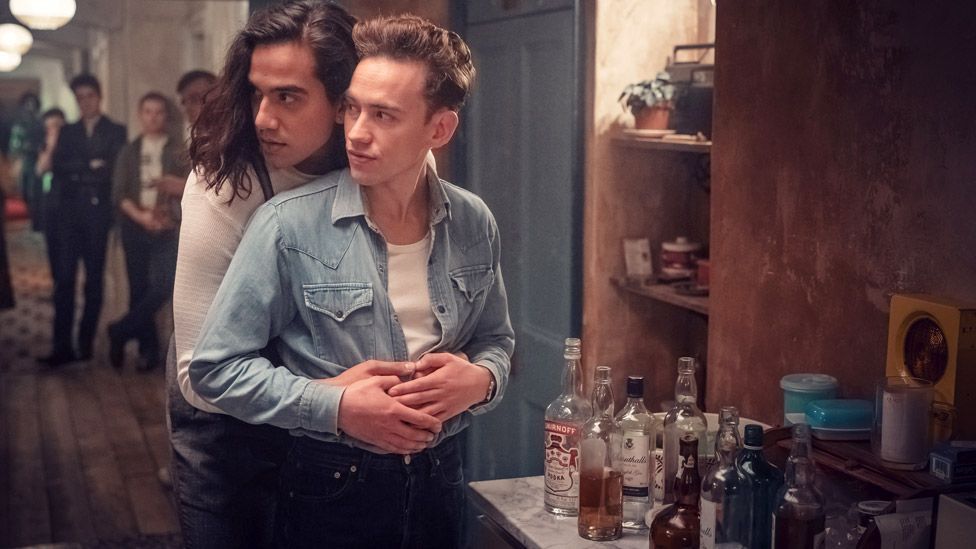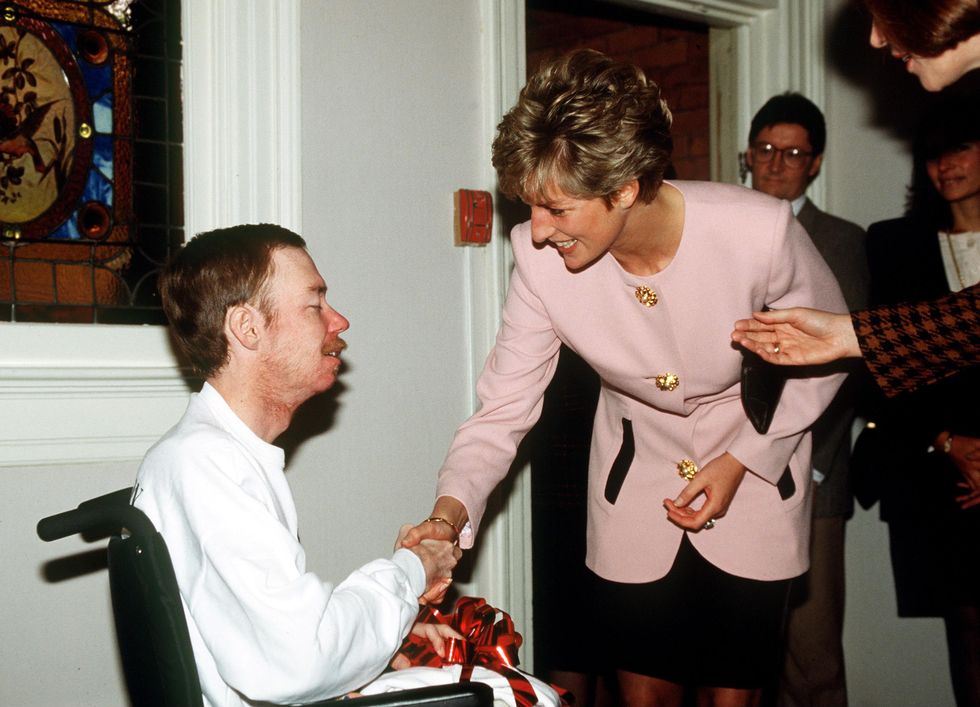It’s A Sin starts like so many other coming-of-age TV shows and films: young people escaping their homes, in search of a dazzling future in the big city. But for this gang of friends, who find each other in London’s gay community in the early Eighties, a shadow is looming.
Insidiously, the Aids epidemic creeps into their lives, first through radio and TV news reports, then scurrilous tabloid rumours and hushed talk in bars, until suddenly the mystery illness reaches people they know.
Though the plot and characters are fictional, creator Russell T Davies drew on his own experiences as a young, gay man growing up during the Eighties for It’s a Sin. As such, the stories that emerge from the series are a true depiction of how British society ostracised and pilloried those living with – and dying from – this horrifying new disease.
In episode one, when Colin (Callum Scott Howells), the gentle apprentice tailor, goes to visit his friend Henry (Neil Patrick Harris) in hospital, he finds him locked up, alone in a ward, with his meals dumped outside the door. When another character is diagnosed with Aids, he’s also put under lock and key in hospital, this time legally, under a Public Health Act. Meanwhile, funeral homes refuse to bury the bodies of those with Aids-related illnesses, while families burn the belongings of the deceased.
These shameful cases haven’t been embellished for dramatic purposes, says Ian Green, CEO of the Terrence Higgins Trust (THT). The producers of the show consulted with THT – the charity's former director of policy acted as an advisor on the series – to help develop storylines that reflected situations gay men actually found themselves in during the Eighties. “The story of the main character locked up under the Public Health Act,” says Green, “this was a real life case that the Trust were involved with and did a lot of campaigning work on. With legal help – who you can also see in the series – we fought really hard to have that person released.”
Green – who was 18 at the beginning of the Aids epidemic – adds: “There was so much misinformation around, because people didn’t know what the virus was. From politicians to the medical community, many people didn’t want to know about it, and there was a real lack of understanding how the virus was contracted, and that perpetuated the fear and led to the stigma that still remains today.
“There was a sense of doom in that we didn’t know how it was going to pan out.”
The beginning of the Aids and HIV crisis
The first cases of the new disease were recorded in America in 1981, among the gay community, which led to it originally being labelled Gay Related Immune Deficiency (GRID). Shortly after, the UK saw its first deaths, including Terry Higgins, who died in 1982 aged 37.
The Conservative government of the day, led by Margaret Thatcher, failed to address the crisis until it had spiralled into an epidemic. From the first deaths, it took a staggering four years for the government to even put together a committee and public health messaging campaign.
In that time, it wasn’t just the virus that was getting a stronghold, but the rumours and conspiracy theories around the disease.
As the naive skeptic Ritchie (Olly Alexander) repeats in It’s A Sin: “They say it was set up in a laboratory to kill us...it’s the Russians...it’s from the jungle.” He also latches on to early messaging, which identified the groups most at risk as homosexuals, Haitians, haemophiliacs and heroin users. He jokes: “Like there’s a disease which just targets the letter ‘h’. Who’s it going to get next? People from Hartlepool?”
At the time, tabloids gleefully ran inhumane headlines like ‘Britain threatened by gay virus plague’ (Mail on Sunday) and ‘I’d shoot my son if he had Aids, says vicar!’ (News Of The World). Meanwhile, those living with the virus were demonised by establishment figures like the chief constable of Greater Manchester, James Anderton – a former minister who believed he had a direct line to God – who referred to patients as “swirling in a human cesspit of their own making”. For many on the religious right, who took issue with homosexuality on supposedly ‘moral’ grounds, the disease now ravaging the gay community was considered some sort of divine retribution.
“There was a huge focus on homophobia as this was affecting a marginalised group,” Green says. “This was a sense of pervading immorality and gay people were seen as immoral. Many people said, ‘well they deserved it, didn’t they?’ It took an awful long time for politicians and clinicians to take action.
“The worst misstep in the handling of the crisis was the delay, not taking it seriously. It was people who set up the THT and activists, who needed to fight to make it happen. Without the heroic willingness of these people and their protests, I worry the government would have taken much longer to take action and many more thousands of people would have died.”
‘Don’t Die of Ignorance’
As the virus continued to spread, misinformation proved equally transmissible. In 1987, a full five years after the first Aids deaths, the Football Association started the season by warning its players not to use communal baths or swap shirts at the end of matches. A campaign that accurately explained Aids and the virus that caused it, human immunodeficiency virus (HIV), was desperately needed.
That came in the form of a hard-hitting advert, known as the tombstone campaign. According to Norman Fowler, the health secretary at the time who was instrumental in its creation, it was “the biggest public health campaign there’s ever been in this country”.
The 40-second advert – directed by Nicolas Roeg – features explosions, dark metal chimes and an ominous tombstone with the word ‘Aids’ carved into it. The advert was groundbreaking because it targeted the disease, rather than the people who were infected. For the first time, it made clear to the public that the virus could be passed on by sexual intercourse, and that “anyone could get it, man or woman”. The spot finished with an enduring strapline: “Don’t die of ignorance”. Leaflets with the same title went through the letterbox of every household in the UK.
There are now mixed feelings about this campaign among the community, Green explains.
“I want to give a huge amount of credit to Norman Fowler, who was one of the first politicians who took HIV seriously. He really had to persuade Margaret Thatcher to allow this national awareness campaign to take place. I’m certain it saved lives.
“However, with hindsight, it was so raw, even today many people’s beliefs about HIV are based on what we knew in the Nineties. It did an awful lot to perpetuate stigma. We now know that HIV is a manageable condition, that people on treatment can now have a normal life expectancy. Things have changed massively, but people’s opinions haven’t. But it was right for the time and was absolutely vital.”
Section 28
Sadly, information became even harder for young people to come by with the introduction of Section 28, the 1988 law that stated a local authority "shall not intentionally promote homosexuality or publish material with the intention of promoting homosexuality" or "promote the teaching in any maintained school of the acceptability of homosexuality as a pretended family relationship". In other words, the discussion of same-sex relationships was functionally banned in classrooms. In It’s a Sin, Ash (Nathaniel Curtis) is shown being forced to remove books from the school library that might “promote a homosexual lifestyle”.
It was another blatant display of the homophobia that ran through the heart of government. In 1987, Thatcher said: “Children who need to be taught to respect traditional moral values are being taught that they have an inalienable right to be gay. All of those children are being cheated of a sound start in life." This knee-jerk reaction is still being felt in classrooms today, and even though it was repealed in 2003 (and David Cameron called it a ‘mistake’ in 2009) LGBTQ+ charity Stonewall says just 13 per cent of students say they have been taught about same-sex relationships in the classroom.
By the start of the Nineties, high profile celebrities and royalty began to use their platforms to raise awareness for the disease. Elton John set up his Aids foundation in 1993, and Princess Diana began visiting patients in hospital, where she reiterated it was safe to shake hands. “Colleagues tell me she used to visit privately as well,” says Green. “She used to go in late at night and would sit with the young men to comfort them. Many of them were ostracised by their families, so many of them were dying on their own. To have somebody like the Princess who would spend time with them was so important.”
While there has been a vast progress in the treatment of Aids and HIV in this country – it’s no longer a death sentence, and with the right treatment, it’s impossible for those living with HIV to pass it on – It’s A Sin will take many people back to a time of fear and confusion in the UK.
“I think it’s really important that the generation today understands the real impact of HIV on the community, and the pain that people still feel,” says Green. “I think it’s going to trigger a lot in people of my generation. In my group of close friends, we lost four friends to HIV, and this is going to be a time we will remember them. But it will bring back tough memories.
“The fact that Russell T Davies is doing it – he’s an amazing writer and producer – there’s no one better, because of his own personal experiences of being a gay man at that time. I think it’s a story that’s been waiting to be told.”
It’s A Sin starts on Channel 4 on Friday 22 January at 9pm.
If you’ve been affected by any of the issues in this article, you can contact the Terrence Higgins Trust on 0808 802 1221 or by emailing info@tht.org.uk
Like this article? Sign up to our newsletter to get more articles like this delivered straight to your inbox
Need some positivity right now? Subscribe to Esquire now for a hit of style, fitness, culture and advice from the experts

















